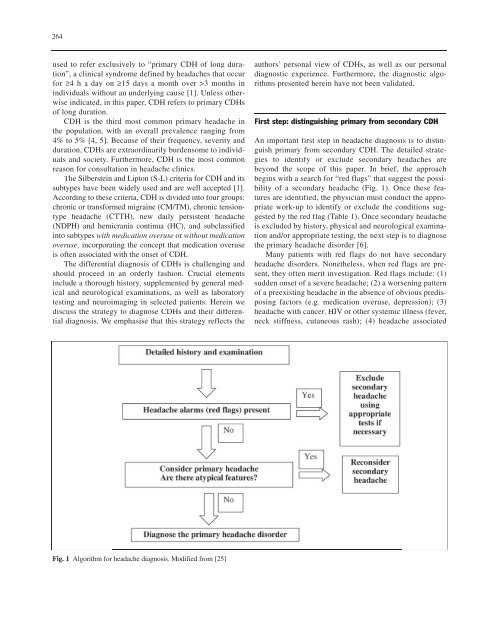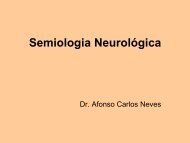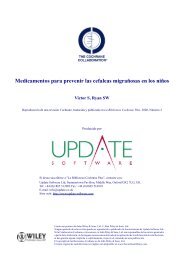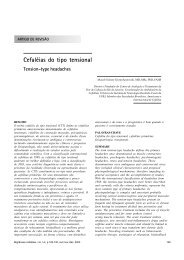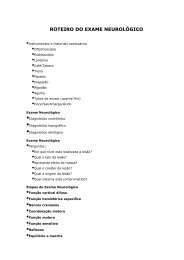The differential diagnosis of chronic daily headaches: an ... - marchioli
The differential diagnosis of chronic daily headaches: an ... - marchioli
The differential diagnosis of chronic daily headaches: an ... - marchioli
Create successful ePaper yourself
Turn your PDF publications into a flip-book with our unique Google optimized e-Paper software.
264<br />
used to refer exclusively to “primary CDH <strong>of</strong> long duration”,<br />
a clinical syndrome defined by <strong>headaches</strong> that occur<br />
for ≥4 h a day on ≥15 days a month over >3 months in<br />
individuals without <strong>an</strong> underlying cause [1]. Unless otherwise<br />
indicated, in this paper, CDH refers to primary CDHs<br />
<strong>of</strong> long duration.<br />
CDH is the third most common primary headache in<br />
the population, with <strong>an</strong> overall prevalence r<strong>an</strong>ging from<br />
4% to 5% [4, 5]. Because <strong>of</strong> their frequency, severity <strong>an</strong>d<br />
duration, CDHs are extraordinarily burdensome to individuals<br />
<strong>an</strong>d society. Furthermore, CDH is the most common<br />
reason for consultation in headache clinics.<br />
<strong>The</strong> Silberstein <strong>an</strong>d Lipton (S-L) criteria for CDH <strong>an</strong>d its<br />
subtypes have been widely used <strong>an</strong>d are well accepted [1].<br />
According to these criteria, CDH is divided into four groups:<br />
<strong>chronic</strong> or tr<strong>an</strong>sformed migraine (CM/TM), <strong>chronic</strong> tensiontype<br />
headache (CTTH), new <strong>daily</strong> persistent headache<br />
(NDPH) <strong>an</strong>d hemicr<strong>an</strong>ia continua (HC), <strong>an</strong>d subclassified<br />
into subtypes with medication overuse or without medication<br />
overuse, incorporating the concept that medication overuse<br />
is <strong>of</strong>ten associated with the onset <strong>of</strong> CDH.<br />
<strong>The</strong> <strong>differential</strong> <strong>diagnosis</strong> <strong>of</strong> CDHs is challenging <strong>an</strong>d<br />
should proceed in <strong>an</strong> orderly fashion. Crucial elements<br />
include a thorough history, supplemented by general medical<br />
<strong>an</strong>d neurological examinations, as well as laboratory<br />
testing <strong>an</strong>d neuroimaging in selected patients. Herein we<br />
discuss the strategy to diagnose CDHs <strong>an</strong>d their differen-<br />
tial <strong>diagnosis</strong>. We<br />
emphasise that this strategy reflects the<br />
authors’ personal view <strong>of</strong> CDHs, as well as our personal<br />
diagnostic experience. Furthermore, the diagnostic algorithms<br />
presented herein have not been validated.<br />
First step: distinguishing primary from secondary CDH<br />
An import<strong>an</strong>t first step in headache <strong>diagnosis</strong> is to distinguish<br />
primary from secondary CDH. <strong>The</strong> detailed strategies<br />
to identify or exclude secondary <strong>headaches</strong> are<br />
beyond the scope <strong>of</strong> this paper. In brief, the approach<br />
begins with a search for “red flags” that suggest the possibility<br />
<strong>of</strong> a secondary headache (Fig. 1). Once these features<br />
are identified, the physici<strong>an</strong> must conduct the appropriate<br />
work-up to identify or exclude the conditions suggested<br />
by the red flag (Table 1). Once secondary headache<br />
is excluded by history, physical <strong>an</strong>d neurological examination<br />
<strong>an</strong>d/or appropriate testing, the next step is to diagnose<br />
the primary headache disorder [6].<br />
M<strong>an</strong>y patients with red flags do not have secondary<br />
headache disorders. Nonetheless, when red flags are present,<br />
they <strong>of</strong>ten merit investigation. Red flags include: (1)<br />
sudden onset <strong>of</strong> a severe headache; (2) a worsening pattern<br />
<strong>of</strong> a preexisting headache in the absence <strong>of</strong> obvious predisposing<br />
factors (e.g. medication overuse, depression); (3)<br />
headache with c<strong>an</strong>cer, HIV or other systemic illness (fever,<br />
neck stiffness, cut<strong>an</strong>eous rash); (4) headache associated<br />
Fig. 1 Algorithm for headache <strong>diagnosis</strong>. Modified from [25]


